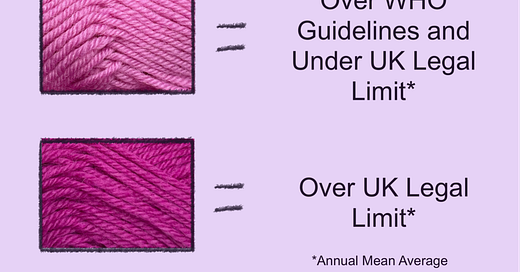Following our last blog on data visualisation, we’ve got something special for you this week.
What?
A growing collective of knitters are putting their craft to the test by knitting the data from two Breathe London nodes in Poplar, Tower Hamlets for a whole year.
The first node is situated outside a primary school and nursery, with residential housing around. The second is nearby, on the A12 as it approaches the Blackwall Tunnel.
Why?
An excellent question! There is a long tradition of knitting data. This knitter created a scarf which tracked train delays on their daily commute and this group has been using knitting to show temperature changes over time. Plus, knitting is essentially coding, before coding was a thing.
So why not air quality data? One of the big challenges in raising awareness of air quality is making the information tangible and accessible for the general public to understand. By presenting air quality data in a highly visual and tactile way, Knitting the Air aims to help make it more accessible for communities.
How?
How is the group doing this exactly? Well firstly, they’ve translated the PM 2.5 particulates and Nitrogen Dioxide readings into two colour keys. These colours indicate how hourly readings relate to WHO recommended guidelines and UK annual legal limits.


Then they download the raw data from the Breath London website, colour-code the readings using the key above, and then they knit it.



Thus each square represents a full day of air quality data.




Once the squares are completed, they will be sewn together a bit like a monthly calendar. That way people will be able to see the squares in a logical sequence, spot patterns and easily compare against each other.
What next?
Well firstly, a lot of knitting! This project started in March this year and for data fans out there, the finished blankets will be made up of nearly 1,500 individual squares. That’s nearly 1.7 million individual knitting stitches! Fortunately, there is a growing group of local knitters lending a hand (and their needles) to make this happen.
As these air quality blankets grow, they will be showcased to the public and communities to open up discussions about air quality and build knowledge locally.
You can follow their progress on Instagram @knittingtheair. Please also comment below if this has inspired you, or if you have other creative ways of visualising air quality data!
Knitting the Air is part of Poplar Green Futures, a community-led strategy and action plan for a healthier, more sustainable Poplar. To get in touch to find out more contact Caroline on caroline.murray@poplarharca.co.uk.





